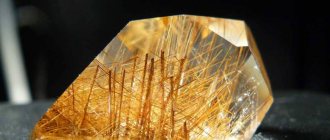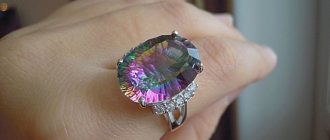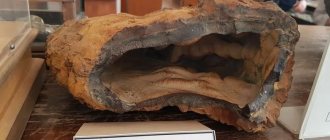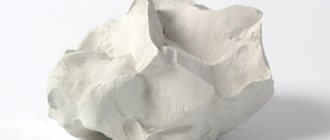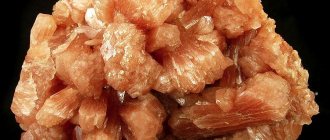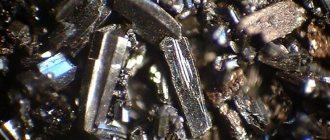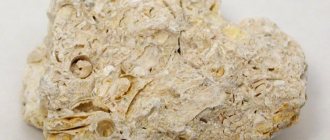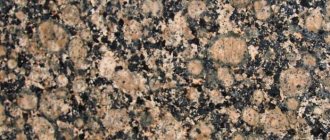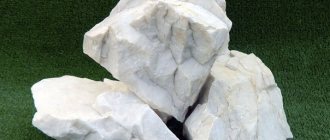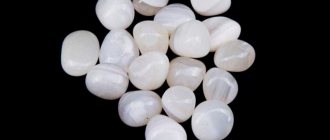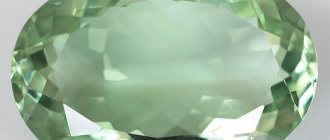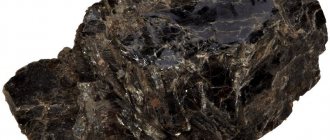Good day, friends. The chemical formula of quartz is SiO2. Quartz deposits, even with active mining, have not yet dried up, so the mineral is widely used in various spheres of life. In their raw form, these are crystals from which material suitable for making jewelry and glass is obtained. What kind of quartz is it, how and where is it formed and what properties does it have? Interesting facts in the article.
It is believed that quartz and gold are constant companions in nature, so modern prospectors still take quartz deposits as a guide when searching for the yellow metal. A simple chemical formula makes it easy to obtain a synthetic analogue of quartz in the laboratory. Artificial material has more impressive characteristics than natural material; moreover, visually it looks brighter and richer. It is not surprising that in the jewelry world, products are often inlaid with quartz imitation.
Crystallographic characteristics
Syngony. A higher temperature modification of β-quartz crystallizes in the hexagonal system, hexagonal-trapezohedral c. With. L66L2.
The modification of α-quartz, which is more stable at temperatures below 573 °C (at atmospheric pressure), crystallizes in the trigonal system, trigonal-trapezohedral c. With. L33L3. Space group P3121(D43) or P3221(D53) (right and left enantiomorphic modifications). a0 = 4.904, c0 = 5.397.
Crystal structure
Crystal structures are quite simple.
Crystal structure of β-quartz. In each SiO4 tetrahedron, two oxygen ions are located slightly higher, and the other two are located slightly lower than the silicon ion. Groups of tetrahedrons lie in three layers at different heights. Tetrahedra form spirals, each of which twists in the same direction. The so-called right and left quartz differ in that the inversion of these spirals occurs to the right or to the left. A rotation around the gear axis by 60° and a translation of one third of the height of the unit cell along the c axis leads to a coincidence with the previous position of the tetrahedra.
The low-temperature modification of α-quartz is only slightly different in its crystal structure from β-quartz. During the polymorphic transformation of a high-temperature modification into a low-temperature one, small displacements of the centers of silicon-oxygen tetrahedra occur, resulting in a compaction of the lattice and a decrease in its symmetry: six-axes turn into triple ones. In this case, the type of bond between tetrahedral groups does not change. During the transformation process, there are no changes in the directions of the spirals (to the right or to the left).
Magic force
The mineral is also credited with magical powers, as it is believed to have strong energy. In this area, balls, lenses and stone crystals are used, which are used in sacrificial and spiritualistic sessions, predicting the future and other rituals. Among the magical abilities of quartz are the following:
rock crystal can program a person to perform certain actions;- rose quartz relieves the owner from touchiness, hot temper and gives him self-confidence;
- green crystals relieve drowsiness and give energy, establishing a connection with higher powers;
- the smoky mineral saves a vulnerable soul from offenders;
- red quartz helps you decide on a partner and bewitch the one the owner of the stone likes;
- The white mineral frees the soul and thoughts from vicious ideas and dark plans.
Astrologers believe that products made from this stone are suitable for Taurus, Leo, Aries, Aquarius, Sagittarius, Libra and Scorpio. This stone is not recommended for Virgos and Geminis.
Form of being in nature
Crystal intergrowth
The appearance of quartz crystals. Quartz crystals are elongated, prismatic in appearance.
Crystals of β-quartz, or rather, paramorphoses of α-quartz after it, found in silica-rich effusive rocks (rhyolites, quartz porphyries, etc.) as early separations from liquid magma, have the appearance of a hexagonal dipyramid, and the faces of the prism are greatly shortened or absent altogether. They are usually very small, but in some breeds they reach 1–2 cm in diameter. Low-temperature α-quartz in well-formed crystals occurs only in voids or loose environments. Individual crystals of very large sizes are known, up to 1 and even 40 tons in weight. The shapes of the crystals, although very diverse, are extremely characteristic by the presence of prism faces m (101–0), often with horizontal hatching, faces of rhombohedrons r (101–1) and z (011–1), trigonal dipyramid s {112–1}, trigonal trapezohedron {516–1}, etc. There are individuals in which the faces of the main rhombohedrons are equally developed, and the crystals in such cases take the form of a “hexagonal dipyramid.”
Being etched, the edges of one rhombohedron remain shiny, while the other becomes matte. The etching patterns are also not the same. Based on the position of the faces of the trigonal trapezohedron {516–1} and bipyramid {112–1}, right and left are distinguished. These faces are confined to the edges of the prism (every 120°), located at the top and bottom, but on different sides of the edge.
In addition to the clearly crystalline modifications of α-quartz and β-quartz, cryptocrystalline dense varieties with a fibrous structure are known: chalcedony (fibers elongated along one of the L2 axes) and quartzine (fibers elongated along L3), reliably distinguishable from each other only by optical properties (in particular , according to the sign of elongation).
Doubles
Mineral twins are observed quite often and according to different laws. 1. Dauphinaean twins grow into each other so completely that they resemble simple quartz crystals, from which they differ in that the faces of the trapezohedron x are observed in double quantity and are separated from each other by a rotation around the vertical axis not by 120°, but by 60°. The faces of the prism of both individuals merge, and the faces of the rhombohedron r coincide with the faces of the rhombohedron z. The optical axes of both individuals are parallel, and therefore the twin structure can only be established by etching. Twin seams are sinuous. 2. Brazilian twins differ from Dauphinean ones in that in them the faces of trapezohedrons, observed in double quantity, are displayed differently: by reflection in the vertical plane. The twin structure is revealed by etching. In contrast to the structure of the Dauphinaean twins, here we observe linear twin seams. In addition, Brazilian twins can also be detected optically. 3. Japanese doubles along the trigonal dipyramid {112–2}; individuals are inclined to each other at an angle of 84°34′.
The fracture of massive fine-grained varieties of stone is flat-shelled to rough or splintered. Fibrous varieties have a rough, jagged, or splintered fracture.
Aggregates
Quartz is found in single crystals, their intergrowths of various types (druze, brushes, etc.), in granular masses, in the form of irregularly shaped grains, in the form of continuous masses and veins.
Druses of quartz crystals are widespread in the voids, sometimes intergrown with crystals of other minerals. Solid masses of quartz are granular aggregates. The structure of dense aggregates is easily established in thin sections under a microscope with crossed nicols. Chalcedony, which has a cryptofibrous structure, is often observed in the form of crusts, kidney-shaped forms or spherulites, but more often in the form of nodules called flints. Agates (siliceous geodes) have a concentrically zonal structure, caused by the intermittency of differently colored layers of chalcedony and sometimes quartz. The central parts of geodes are often composed of crystalline-grained quartz, sometimes in the form of brushes of crystals.
Veins of gold in quartz. Magadan region, Utinskoye field
Principle and stages of material formation
For quartz crystals to form in nature, certain conditions must be met. First of all, it is a suitable temperature, secondly, a certain pressure. The mineral appears mainly in igneous rocks, so deposits are mainly found near active volcanoes and geysers.
Under the influence of high temperatures, the magma erupted by volcanoes solidifies, creating the conditions necessary for the formation of quartz. Different types of breed are suitable for certain areas of industry and more.
Physical properties of quartz
Optical
Color. The color of quartz varies. Most often it is colorless, white, gray, but there are also colored varieties.
Transparent or translucent beautifully colored varieties of quartz have special names. Their names and colors are given in varieties. In addition to the listed transparent varieties of the mineral, clearly allochromatically colored quartz crystals are observed due to inclusions of foreign minerals, which also have their own names: prazem - greenish quartz with inclusions of green actinolite needles: aventurine - yellowish or brownish-red quartz with a shimmering tint caused by tiny inclusions of mica, iron mica Fe2O3, etc.
Widespread in hydrothermal deposits, quartz is milky white in color. Almost always in liquid inclusions there is a mobile gas bubble, by which the liquid is easily recognized, and sometimes even NaCl crystals. When heated at a certain temperature, these crystals dissolve, then the gas bubbles disappear and a homogeneous liquid phase is formed. When cooled, it becomes heterogeneous again. In this way, it is possible to establish approximately at what temperature the entrapment of these liquid phases during the crystallization process could occur. In other cases, the milky-white color of quartz crystals is due to a strong Add to dictionary that arose during dynamic influences (similar to how completely transparent ice becomes milky-white when hit with a hammer in a damaged area.
- Doesn't give a damn.
- Glass shine on the edges of the crystal,
- The cast is greasy at the break.
- Transparency. quartz is translucent, less often transparent.
- Quartz is optically uniaxial, positive. Ng = 1.553 and Nm = 1.544. It has the ability to rotate the plane of polarization in one direction or another, depending on whether we are dealing with the right or the left.
Mechanical
- The standard hardness of quartz is 7.
- Density 2.65.
Chemical properties
Quartz is resistant to weathering (does not decompose chemically). It does not react with acids, with the exception of HF, with which it easily forms a volatile compound - SiF4. Susceptible to alkalis.
Varieties
Let's look at the main, most notable varieties of the mineral:
- Agate is one of the varieties of chalcedony with a banded-layered structure.
- Aventurine – has a reddish or yellowish tint with inclusions of mica.
- Amethyst is a beautiful purple color.
- Tiger (falcon, bull's) eye is a brown-crimson colored stone.
- Binghemite is an iridescent quartz notable for its inclusions of goethite.
- Rock crystal is colorless, transparent crystalline formations.
- Volosatik is a type of rock crystal with inclusions of rutile finely needle-shaped particles, as well as tourmaline and other needle-shaped minerals.
- Flint is represented by cryptocrystalline silica aggregates of a fine-grained structure, the basis of which is quartz with a small admixture of cristobalite and chalcedony. Sometimes it contains opal in small quantities. Typically found in the form of pebbles and nodules.
- Prazem is notable for the presence of actinolite and has a distinct green tint.
- Overlivt is a layered mineral consisting of microcrystals of chalcedony and quartz, having an opaque appearance.
- Morion is a variety presented in black.
- Rose quartz.
- Smoky (rauchtopaz) – has a light brown/light gray color.
- Prasolite – has a green onion tint. It is formed artificially, due to the calcination of yellow quartz samples.
- Onyx is a brown mineral with natural black-brown patterns. It may also have a honey, brown-red, white, pinkish and yellowish plane-parallel layer in its composition.
- Citrine is a lemon-yellow stone.
- Heliotrope is a dark green stone of the cryptocrystalline variety of silica. Mainly presented in the form of fine-grained formations, rarely with admixtures of chalcedony, hydroxide and iron oxide. May have stripes and spots of a bright red hue.
- Chalcedony is a fine-fiber, cryptocrystalline stone with a translucent or translucent structure and a color spectrum from honey/yellow to white. It forms spherulitic crust and spherulite, continuous massifs, and also occurs in the form of pseudostalactite formations.
Other properties
Transverse hatching on the faces of prismatic crystals.
Quartz is capable of transmitting ultraviolet rays. It has the property of piezo-electrification: under the influence of mechanical stress, electrical charges arise in quartz. The electric axes are double, and the end of each double axis, which abuts the edge cut off by the faces of the trapezohedron, is electrified negatively, and the opposite end - positively. Melting point 1713 °C. When the melt solidifies, quartz glass is easily formed, which has a number of special properties (acid resistance, low expansion coefficient, ability to transmit ultraviolet rays, etc.).
Diagnostic signs
Diagnostics. Quartz is easily recognized by its prismatic crystals with cross-hatching, conchoidal fracture, high hardness (7), glassy or greasy luster. May be confused with opal, chalcedony, feldspar or nepheline. The first two differ from quartz in their waxy luster and dense structure. Feldspars are characterized by cleavage (in two directions). Nepheline has a lower hardness (5.5).
Satellites of quartz. Feldspars, micas, hornblende, sulfides, gold, calcite, etc.]
Healing abilities
Supporters of traditional medicine believe that quartz formations have a number of healing properties. One of the most popular recipes for using this mineral is quartz water, which can be made at home. To prepare, the crystals should be placed in water, left for 24 hours, and then passed through filters. It is believed that the resulting liquid has benefits for the body and can treat some diseases.
Its use allows you to fight diseases of the respiratory system. In addition, water has a rejuvenating and antibacterial effect, which is why it is used to treat skin ailments. The liquid fights acne, dermatitis, and with constant use, the skin becomes soft and elastic.
This water has wound-healing and antiseptic properties, so it can be used to prepare compresses for wounds, cuts or burns. The liquid also treats contusions, bruises and hematomas.
Quartz crystal pendants can strengthen the immune system, reduce symptoms of colds and strengthen the central nervous system, reducing the effects of stress. Special properties are attributed to the white mineral. Thanks to the chemical formula of quartzite, when the temperature changes, this stone begins to release ozone substances, which cleanse the body of carbon dioxide and improve the functioning of the lungs.
The mineral also has a good effect on the genitourinary system; purple crystals are considered especially effective. They are used to treat infertility, with decreased reproductive function and to restore potency.
Variegated mix
Astrologer L. Nazarova says that all quartz are the guardians of the present time, through them you can catch the moment of the present and receive Grace.
Collectors especially value fine examples of crystals from alpine veins - mineralized fractures (“crystal cellars”) common in the Alps.
In Brazil, rauchtopaz and amethyst crystals are heat treated. In this way, purple and smoky crystals are transformed into citrine from light yellow to deep golden orange. Such stones are marketed under the names “Brazilian topaz” and “Madeira topaz”.
The strength of quartz is amazing. If you make quartz tiles in your house, countertops or sidewalk paths in your local area, you can be sure that your great-great-grandchildren will admire the beauty of the stone. After all, these products will live for at least 150 years, but most likely much longer.
Are you sure there is no quartz in your home? He is. The smallest specks of dust that exist in any home necessarily contain this mineral.
